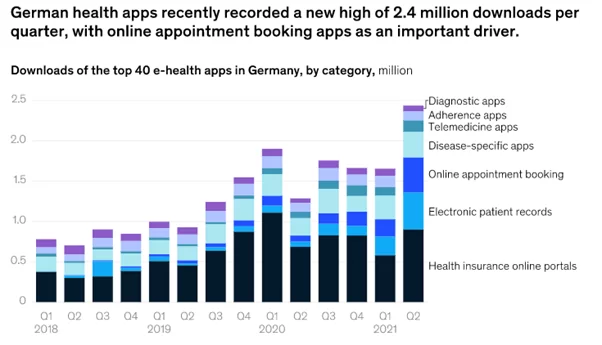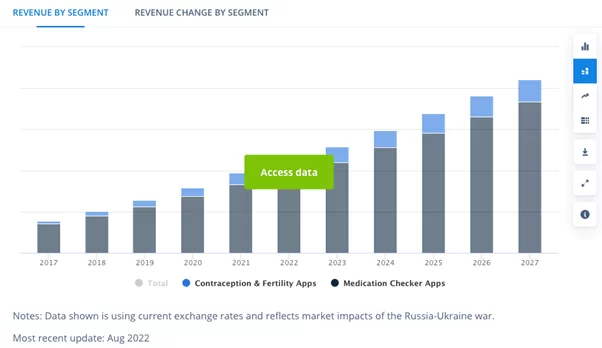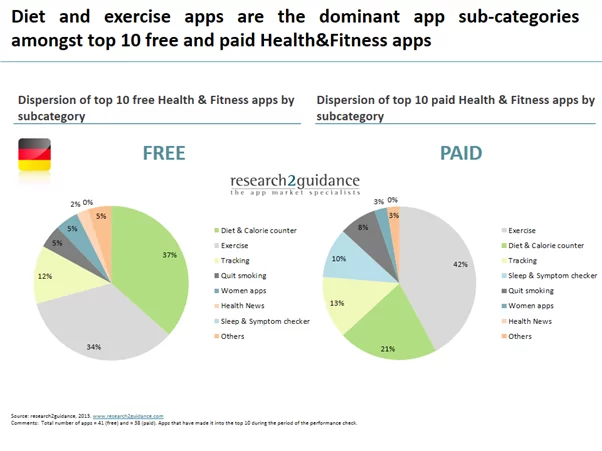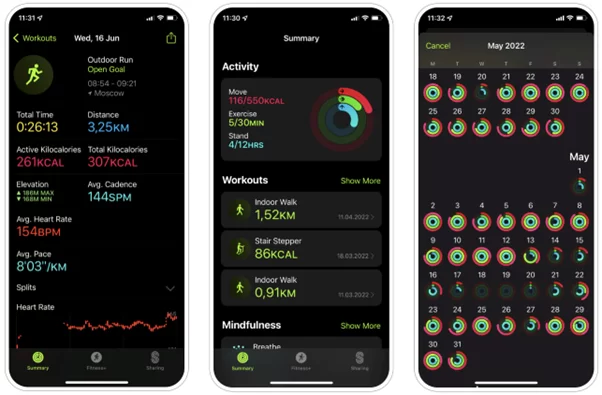Fortune Business Insights expects the German smart healthcare market value to grow to $33.09 billion in 2027 from $6.87 billion in 2019. The popularity of health apps is explained by the fact that they provide people with a quick and easy way to monitor their health, as well as make life easier for doctors and patients. A variety of health solutions are available to consumers today, including fitness apps, women’s health apps, apps for people with chronic diseases, medication management apps, telemedicine, and others.
Every day, developers add new mHealth apps to marketplaces trying to attract German consumers with a pleasant design, user-friendly interface, high performance, and other features. Just imagine that between autumn 2019 and summer 2021, German users downloaded 2.4 million e-health apps. The chart below shows the most popular types of applications among the population.

Source: www.mckinsey.com
If you decide to build a health app for the German market in 2023, this is a great idea. Firstly, any type of healthcare solution will find its user and its niche as the above-mentioned statistics demonstrate that the demand for mHealth products is growing. Secondly, you will make a profit on healthcare applications. According to Statista, revenue in the e-health apps market is expected to amount to $1.84 bln in 2023.

Source: www.statista.com
Building a Health App for the Germany Market
If you want your mobile health app to be successful among German users and meet the requirements of German law, you need to take into account a lot of nuances when creating it.
We’ve created a brief guide that will help you avoid a number of mistakes and launch your product on the market without any problems.
Step 1. Idea
First of all, your mobile health app must meet the needs of the target audience. For this purpose, define the target audience, conduct a market analysis, think about competing features, and so on. Users will appreciate your application if it effectively solves their problems.
You need to choose the type of your health app at this stage, too. Conducting market research will help you see what products are in demand among German users, what applications they would like to see in the market, what niche is still free for new solutions, and so on. The chart below shows that most Germans use diet and calorie counters and exercise apps.

Source: www.recearch2guidance.com
Let’s take a look at the types of e-health apps currently available in the German market.
Types of mHealth apps
Fitness apps
These are solutions that track user activity throughout the day. They allow people to monitor calories, heart rate, steps, and so on. These apps are often paired with wearables, such as smart bracelets and smartwatches. It will be cool to apply elements of game playing to fitness applications to motivate people to achieve better results.
When people worldwide had to stay at home due to the COVID-19 pandemic, fitness app downloads rose by 46%. People enjoyed these solutions so much that many of them didn’t return to the gyms after the removal of all pandemic restrictions. The global fitness app market continues to grow, so you have every chance to succeed in this industry by providing your product with interesting and unique features.
Chronic disease monitoring apps
These solutions are responsible for monitoring chronic diseases. Around three in five Germans suffer from chronic diseases, such as diabetes, cardiovascular diseases, osteoarthritis, and so on. The chronic disease monitoring apps allow patients to record their health data every day and share it with their healthcare providers. If required, the doctor gives recommendations and makes adjustments to therapy.
Remote patient monitoring apps
These apps allow users to search for the specialists they need using various filters, such as specialization, time, cost, location, rating, and so on. Remote patient monitoring apps are popular in Germany, which is confirmed by a study conducted by Mordor Intelligence. According to it, the German patient monitoring app market is projected to reach a CAGR of 6.4% during 2022-2027.
Reminder apps
The purpose of this app is to remind patients about taking medications, making an appointment with a doctor, taking tests, and much more. By the way, 1 in 2 people forget to take medicine in time, which can be fatal in some cases. Medication non-adherence causes 125k premature deaths in the USA every year. Since there are 5,006.05 million smartphone users worldwide today, people won’t forget about taking medication or visiting a doctor.
Mental health apps
These are solutions that help people with mental disorders. These can be applications for searching and communicating with a psychologist via video call or chatting through the platform, as well as various meditation tools. They provide ways to cope with anxiety, depression, and stress, as well as help users maintain good habits, change bad thought patterns, develop healthy attitudes, and much more. According to the study published in the Journal of Medical Internet Research, mental health apps were found effective in managing stress and anxiety in users.
Digital healthcare apps (DIGAs)
This type of app is currently gaining popularity in Germany. These are solutions that are prescribed by doctors to patients after diagnosing them with any disease (for example, depression, migraine, overweight, multiple sclerosis, sleep disturbance, etc.). Unlike conventional health apps, DiGAs are considered medical devices for the treatment of diseases. For instance, medical devices include pacemakers or x-ray machines.
DiGAs are comprehensively tested by the Federal Institute for Drugs and Medical Devices (Bundesinstitut für Arzneimittel und Medizinprodukte, or BfArM). These apps don’t contain ads and are paid through the health insurance fund. You can find the approved digital health applications in the DiGA BfArM catalog.
Step 2. Specifications
Once you’ve chosen the type of health app you’ll create, you’ll need to draw up specifications. It will include the purpose of the project, budget, functional and technical requirements for the app, as well as control and acceptance procedures. Clear and detailed specifications will make the development process simple and easy. According to PMI’s Pulse of the Profession report, about 47% of projects fail due to poor specification.
Step 3. Design
In general, the requirements for a mHealth app are the same as the requirements for a usual mobile app. It should be attractive, responsive, have good navigation, load quickly, and solve all user problems. However, there are some nuances you should consider when designing your solution depending on the type.
For example, if you’re building a fitness app, it’s a good idea to incorporate elements of gamification to instill interest in the activity and retain a user. Let people compete with other customers, compare progress, and be rewarded for good results. FitBit App allows users to invite friends and compete to see who gets the most steps over the weekend or Monday through Friday.

If you’re creating a mental health app, avoid bright colors that can evoke negative feelings and make the patient feel worse. Also, think about the gender, sex, and age of your target audience. According to Statistica, the largest age group in Germany is 40-59-year-olds (23 million people). They are followed by people aged 65 and over (18.44 million). Seniors will most likely use your health app, and you need to develop a successful design for them. Create text size, color variations, navigation, and other features taking into account the behavior patterns and preferences of older people.
Step 4. Development
Based on the specification and design, developers begin to write code. We recommend creating an MVP (Minimum Viable Product) to test user response to the application. You’ll receive the first data on the traffic and use of the app, which will help you improve the product and remove bugs. The cost and duration of the development process depend on many factors, which include the type of app (native or cross-platform), programming language, team, and so on.
Step 5. Testing
When the first version of the app is ready, the testing stage begins. Testers look for bugs and report them to developers. Mobile applications are usually tested for performance, recovery, integration, security, usability, and compatibility. Almost 1 in 2 apps get deleted within 30 days after installation for various reasons. Carefully test your e-health app and don’t give users the chance to uninstall it because of bugs and poor performance.
Step 6. Release
When your app is ready, it will be released on the appropriate platforms. The most popular platforms are App Store and Google Play. To publish an application on Google Play, you’ll have to pay $25. This is a one-time payment. The cost of publishing an app on the App Store is $99 per year.
Step 7. Maintenance
When your health app is released, this doesn’t mean that you’ll forget about it. You’ll constantly update it and add new features to retain users and attract new ones.
Final Word
We’ve described the standard steps of the health app development process. However, depending on the type of application, this process may vary. If you decide to create a digital healthcare app, you need to apply for registration with BfArM and study in detail this process and the requirements for such solutions.
At Elinext, we take care of all stages of development from analytics to publishing applications on the appropriate stores. We’ve already created a lot of healthcare solutions and are ready to answer all your questions regarding the creation of products for the German and other markets. We’ll help you build a number one e-health app that will be in demand among both doctors and patients. Don’t hesitate to contact our specialists.









